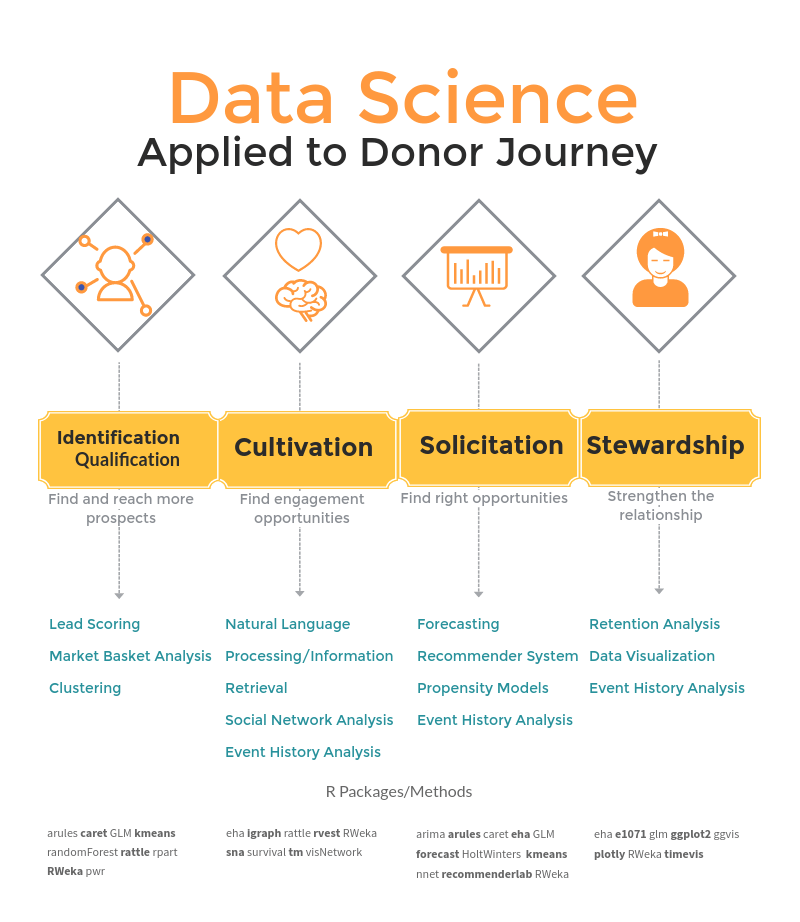Chapter 4 Data Science Applications for Fundraising
4.1 What is Data Science?
“Data science” is a term that describes the systematic process of converting data into actionable insights, decision support and recommendations using computational tools and machine learning techniques. The purpose of data science is to identify trends, confirm intuition, and help us make important predictions about the future using past data.
4.2 How to Use Data Science for Fundraising?
Data science is a tool that can help fundraising professionals understand donor behavior and increase the success of fundraising campaigns. Fundraising analytics creates business value by using data visualization and analysis tools to help identify opportunities, generate leads, guide strategy, prioritize resource allocation, and provide decision support and recommendations relative to campaign goals.
4.3 Problems in Fundraising
Out of the various problems in fundraising, you will agree on the following as the biggest challenges:
Find prospective donors
Maximize available resources
If we don’t find new donors or don’t upgrade existing ones, we won’t generate future donations.
Yet sometimes, having too many prospective donors also creates a problem of “little time for a lot work.” Organizations with limited resources face this problem disproportionately.
Data science offers answers to both of these problems. But first, let’s explore the problems in detail.
4.3.1 Finding Prospective Donors
This is a big and demanding problem. Prospect research professionals spend most of their time on it. It includes finding individuals or organizations who can give, summarizing philanthropic interests, and discovering relationships with their organization:
Finding entities: Typically, we look at the giving history of existing donors as a starting point for further investigation. We also assess the wealth of individuals to put the wealthy ones high on our list for further engagement.
Finding interests: We try to figure out the giving as well as personal interests of individuals to better engage them with our organizations. This approximation of interests helps us create targeted engagement and solicitation opportunities.
Finding relationships: We know that people are willing to act on something if asked by a friend—especially if that something is a request to give. Uncovering relationships among our benefactors and potential donors help us to ask for helps from our friends.
4.4 Maximizing Resources
This is hardly a new problem. Every organization tries to make the most of the available time and people. Fundraising faces the challenge of engaging new potential donors every year with limited staff.
4.5 Are they Really Problems?
Yes: Of course, one would say. Without new donors, our inflow of cash will stop. We need to keep building relationships with the prospective donors and work with the ones who are interested in our causes.
If we don’t use our time wisely and chase after unlikely donors, we will lose potential revenue.
So, yes, these are real problems and data can help us become more productive.
No: These are not problems if:
- the gift officers already have a lot of people in their portfolios. It doesn’t make sense to add more people.
- the practice of systematic qualification is non-existent. If the gift officers don’t qualify using a system, what’s the point of generating more leads?
- the results using data are marginally better than the current practices. To calculate outcomes, first we need to know what to measure. Let’s take the case of events. What’s the measure of success? Even if we used data to create a list of invitees, how would we know we improved on the current practice?
Let’s see how we can apply data science to solve these fundraising problems.
4.6 How to Use Data Science to Solve These Problems?
Let’s divide these problems into two categories: outward and inward looking. When the problems we are trying to solve involve entities outside of our organization, these are outward-looking problems. When we are trying to improve our internal processes, these are looking inward problems.
4.6.1 Outward Looking
Figure 4.1 shows some of the outward-facing problems, divided by the donor cycle, as well as the data science techniques we can use to solve these problems.
FIGURE 4.1: Data science applied to the donor journey
4.6.2 Inward Looking
Table 4.1 shows some of the problems that we face within our organizations as we try to improve our productivity and performance.
| Challenge | How to solve | Which technique to use |
|---|---|---|
| Too many prospects in portfolios | Remove inactive and unlikely-to-give prospects | Predict likelihood of giving |
| Absent fundraiser activity | Create accountability and ranking reports | Simple activity scoring formula |
| Shortfall of major gift officer talent | Find talent within annual giving officers | Predict future activity |
| Limited time to provide information | Automate tasks and reports | Text mining and other programming |